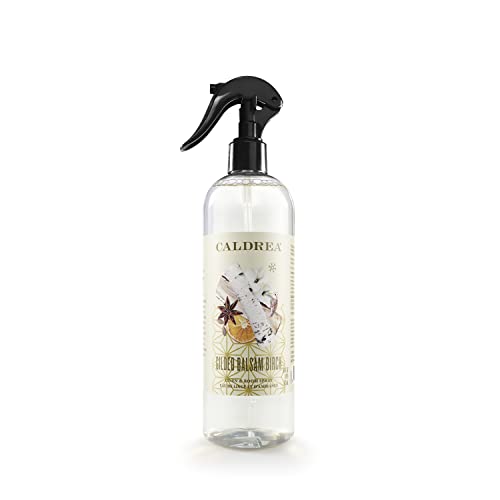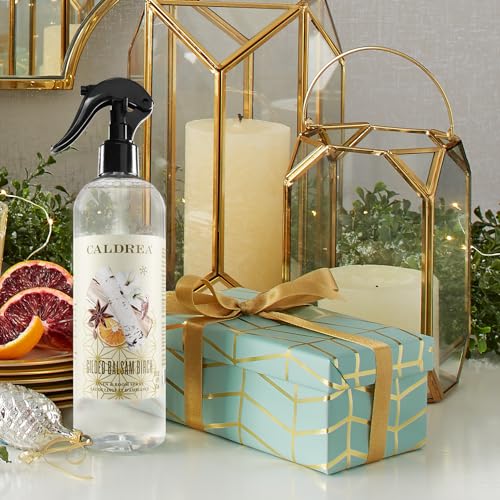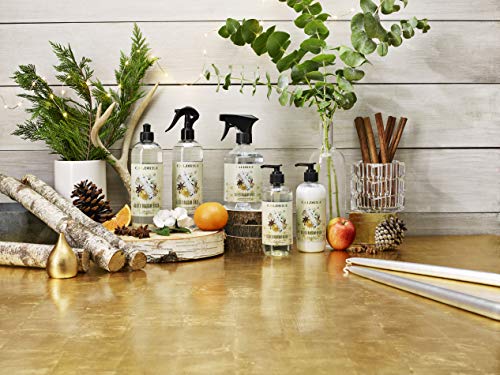






Caldrea Linen & Room Spray - Freshens Fabrics with Essential Oils, Gilded Balsam Birch - 16oz


Benzisothiazolinone
High RiskBenzisothiazolinone is a heterocyclic compound commonly used as a preservative in various products due to its effectiveness in preventing microbial growth. It is often found in paints, coatings, and personal care items.
Sustai Insights
Benzisothiazolinone serves effectively as a preservative, inhibiting bacterial and fungal growth, which prolongs product shelf life. However, it is associated with moderate allergenic potential and has high use restrictions due to regulatory concerns. Environmental risks include its classification as a pollutant, with potential bioaccumulation. Regulatory bodies have flagged it for unacceptable use levels in verified products, leading to an overall high-risk assessment. Safe usage practices are essential, and alternatives such as natural preservatives may be considered.
Fragrance
High RiskFragrance refers to a mixture of aromatic compounds used in products to provide scent. It is commonly listed as 'fragrance' or 'parfum' on product labels and can serve various functions, including enhancing user experience and masking undesirable odors.
Sustai Insights
Fragrance offers functional benefits by improving product appeal; however, it poses significant health risks, notably a high likelihood of causing allergies and allergic contact dermatitis. Environmental risks include potential pollution and endocrine disruption, though its overall carcinogenicity is low. Regulatory bodies have noted concerns regarding its use, leading to a high-risk classification. Safe usage practices should be observed, and alternatives such as natural essential oils are recommended for those sensitive to synthetic fragrances.
Methylisothiazolinone
High RiskMethylisothiazolinone is a widely-used preservative in cosmetic and personal care products, known for its antimicrobial properties. It helps prevent the growth of bacteria and fungi, extending the shelf life of formulations. It is often used in leave-on and rinse-off products, including lotions and shampoos.
Sustai Insights
Methylisothiazolinone serves as an effective preservative, combating microbial growth in various personal care items. However, it is associated with a high risk of allergic reactions and skin sensitization, especially in individuals exposed repeatedly. Regulatory bodies have imposed use restrictions due to these health concerns. Additionally, while it is not considered a carcinogen, its environmental impact includes potential pollutant characteristics. Overall, the risk associated with methylisothiazolinone is high, prompting caution and consideration of safer alternatives.
Citric Acid
Medium RiskCitric acid is an alpha hydroxy acid used in personal care products primarily for its role as a pH adjuster and natural preservative. It occurs naturally in citrus fruits and is commonly utilized in various formulations for its chelating properties and mild exfoliation benefits.
Sustai Insights
Citric acid offers functional benefits as an effective preservative and pH stabilizer, contributing to product longevity and stability. It is biodegradable and derived from renewable sources. Health risks are low, with minimal concerns regarding carcinogenicity, allergies, and reproductive toxicity. However, moderate use restrictions exist due to potential irritation at high concentrations. Environmental risks are limited, as citric acid is not known to accumulate in ecosystems. Regulatory agencies have no significant advisories against its use. Overall, it is assessed as a medium-risk ingredient, with safe usage practices recommended and alternatives available.
Eucalyptus Globulus (Eucalyptus) Leaf Oil
Medium RiskEucalyptus globulus leaf oil is a volatile oil derived from the leaves of the eucalyptus tree, primarily used for its aromatic properties and as a potential antimicrobial agent in various products.
Sustai Insights
Eucalyptus globulus leaf oil offers functional benefits like fragrance and potential antimicrobial properties, supporting product efficacy. However, it presents high allergenic potential and moderate irritation concerns, which may pose health risks. Environmental risks include possible pollution and bioaccumulation. Regulatory restrictions are in place regarding its use in certain products. Overall, the risk level is medium, necessitating caution in usage and consideration of alternatives like tea tree oil or peppermint oil.
Copaiba Oil
Low RiskCopaiba oil is an essential oil derived from the balsam of copaiba trees, primarily found in South America. It is commonly used in various products for its potential therapeutic properties, including anti-inflammatory and analgesic effects.
Sustai Insights
Copaiba oil offers functional benefits such as anti-inflammatory properties and is sustainably sourced from copaiba trees, contributing to its eco-friendliness. Health risks are minimal, with low concerns for carcinogenicity, allergies, and reproductive toxicity. Environmental risks are also low, with no significant pollutant or bioaccumulation concerns. Regulatory bodies, including the FDA, do not impose restrictions on its use. Overall, copaiba oil is assessed as having a low risk profile, making it a viable option in formulations.
Peg 40 Hydrogenated Castor Oil
Low RiskPEG-40 hydrogenated castor oil is a polyethylene glycol derivative of hydrogenated castor oil, commonly used as an emulsifier and surfactant in various cosmetic and personal care products. It helps to improve the texture and stability of formulations by facilitating the blending of oil and water-based ingredients.
Sustai Insights
PEG-40 hydrogenated castor oil offers functional benefits such as effective emulsification and stability enhancement in formulations. It is considered low risk for health concerns, including carcinogenicity and allergenic potential. Environmentally, it is not associated with significant hazards, and regulatory bodies have not imposed strict restrictions. Safe usage practices involve adhering to recommended concentrations. Overall, this ingredient presents a low risk profile with limited environmental impact, making it a suitable choice in cosmetic applications.
Sodium Citrate
Low RiskSodium citrate is used in cosmetic formulations primarily as a buffering agent, helping to stabilize pH levels. It is derived from citric acid and is commonly found in various personal care products to enhance their efficacy and stability.
Sustai Insights
Sodium citrate offers functional benefits such as effective pH regulation and acts as a mild preservative. It is generally recognized as safe with low risks for cancer, allergies, and reproductive toxicity. Environmental concerns are minimal, with no significant pollutant potential or bioaccumulation. Regulatory bodies like the FDA and COSMOS have no major restrictions on its use. Overall, sodium citrate presents a low risk, making it a viable ingredient in cosmetic formulations. Safe usage practices should be followed, and alternatives are not typically necessary.
Citric Acid
Medium RiskCitric acid is an alpha hydroxy acid used in personal care products primarily for its role as a pH adjuster and natural preservative. It occurs naturally in citrus fruits and is commonly utilized in various formulations for its chelating properties and mild exfoliation benefits.
Sustai Insights
Citric acid offers functional benefits as an effective preservative and pH stabilizer, contributing to product longevity and stability. It is biodegradable and derived from renewable sources. Health risks are low, with minimal concerns regarding carcinogenicity, allergies, and reproductive toxicity. However, moderate use restrictions exist due to potential irritation at high concentrations. Environmental risks are limited, as citric acid is not known to accumulate in ecosystems. Regulatory agencies have no significant advisories against its use. Overall, it is assessed as a medium-risk ingredient, with safe usage practices recommended and alternatives available.
Benzisothiazolinone
High RiskBenzisothiazolinone is a heterocyclic compound commonly used as a preservative in various products due to its effectiveness in preventing microbial growth. It is often found in paints, coatings, and personal care items.
Sustai Insights
Benzisothiazolinone serves effectively as a preservative, inhibiting bacterial and fungal growth, which prolongs product shelf life. However, it is associated with moderate allergenic potential and has high use restrictions due to regulatory concerns. Environmental risks include its classification as a pollutant, with potential bioaccumulation. Regulatory bodies have flagged it for unacceptable use levels in verified products, leading to an overall high-risk assessment. Safe usage practices are essential, and alternatives such as natural preservatives may be considered.
Fragrance
High RiskFragrance refers to a mixture of aromatic compounds used in products to provide scent. It is commonly listed as 'fragrance' or 'parfum' on product labels and can serve various functions, including enhancing user experience and masking undesirable odors.
Sustai Insights
Fragrance offers functional benefits by improving product appeal; however, it poses significant health risks, notably a high likelihood of causing allergies and allergic contact dermatitis. Environmental risks include potential pollution and endocrine disruption, though its overall carcinogenicity is low. Regulatory bodies have noted concerns regarding its use, leading to a high-risk classification. Safe usage practices should be observed, and alternatives such as natural essential oils are recommended for those sensitive to synthetic fragrances.
Eucalyptus Globulus (Eucalyptus) Leaf Oil
Medium RiskEucalyptus globulus leaf oil is a volatile oil derived from the leaves of the eucalyptus tree, primarily used for its aromatic properties and as a potential antimicrobial agent in various products.
Sustai Insights
Eucalyptus globulus leaf oil offers functional benefits like fragrance and potential antimicrobial properties, supporting product efficacy. However, it presents high allergenic potential and moderate irritation concerns, which may pose health risks. Environmental risks include possible pollution and bioaccumulation. Regulatory restrictions are in place regarding its use in certain products. Overall, the risk level is medium, necessitating caution in usage and consideration of alternatives like tea tree oil or peppermint oil.
Copaiba Oil
Low RiskCopaiba oil is an essential oil derived from the balsam of copaiba trees, primarily found in South America. It is commonly used in various products for its potential therapeutic properties, including anti-inflammatory and analgesic effects.
Sustai Insights
Copaiba oil offers functional benefits such as anti-inflammatory properties and is sustainably sourced from copaiba trees, contributing to its eco-friendliness. Health risks are minimal, with low concerns for carcinogenicity, allergies, and reproductive toxicity. Environmental risks are also low, with no significant pollutant or bioaccumulation concerns. Regulatory bodies, including the FDA, do not impose restrictions on its use. Overall, copaiba oil is assessed as having a low risk profile, making it a viable option in formulations.
Methylisothiazolinone
High RiskMethylisothiazolinone is a widely-used preservative in cosmetic and personal care products, known for its antimicrobial properties. It helps prevent the growth of bacteria and fungi, extending the shelf life of formulations. It is often used in leave-on and rinse-off products, including lotions and shampoos.
Sustai Insights
Methylisothiazolinone serves as an effective preservative, combating microbial growth in various personal care items. However, it is associated with a high risk of allergic reactions and skin sensitization, especially in individuals exposed repeatedly. Regulatory bodies have imposed use restrictions due to these health concerns. Additionally, while it is not considered a carcinogen, its environmental impact includes potential pollutant characteristics. Overall, the risk associated with methylisothiazolinone is high, prompting caution and consideration of safer alternatives.
Peg 40 Hydrogenated Castor Oil
Low RiskPEG-40 hydrogenated castor oil is a polyethylene glycol derivative of hydrogenated castor oil, commonly used as an emulsifier and surfactant in various cosmetic and personal care products. It helps to improve the texture and stability of formulations by facilitating the blending of oil and water-based ingredients.
Sustai Insights
PEG-40 hydrogenated castor oil offers functional benefits such as effective emulsification and stability enhancement in formulations. It is considered low risk for health concerns, including carcinogenicity and allergenic potential. Environmentally, it is not associated with significant hazards, and regulatory bodies have not imposed strict restrictions. Safe usage practices involve adhering to recommended concentrations. Overall, this ingredient presents a low risk profile with limited environmental impact, making it a suitable choice in cosmetic applications.
Sodium Citrate
Low RiskSodium citrate is used in cosmetic formulations primarily as a buffering agent, helping to stabilize pH levels. It is derived from citric acid and is commonly found in various personal care products to enhance their efficacy and stability.
Sustai Insights
Sodium citrate offers functional benefits such as effective pH regulation and acts as a mild preservative. It is generally recognized as safe with low risks for cancer, allergies, and reproductive toxicity. Environmental concerns are minimal, with no significant pollutant potential or bioaccumulation. Regulatory bodies like the FDA and COSMOS have no major restrictions on its use. Overall, sodium citrate presents a low risk, making it a viable ingredient in cosmetic formulations. Safe usage practices should be followed, and alternatives are not typically necessary.
Transform your space with the enchanting Caldrea Gilded Balsam Birch Linen and Room Spray. Crafted with essential oils and thoughtfully chosen plant-derived ingredients, this air freshener not only revitalizes your home but also envelops it in a signature scent that evokes the warmth of a cozy winter retreat.
- Freshness Anywhere: Instantly freshens up rooms, linens, and even your car with a simple spray, creating a welcoming environment wherever you go.
- Versatile Use: Perfect for any setting—mist on fabrics, carpets, or in the air to enjoy the delightful fragrance throughout your home.
- Natural Ingredients: Made without artificial colors, parabens, or animal-derived ingredients, ensuring a healthier choice for your space.
- Easy Application: Simply shake, spray, and enjoy. This user-friendly design allows for effortless scent distribution.
- Trusted Quality: Backed by positive customer reviews and crafted with care, this product embraces sustainability while enhancing your living environment.
Subscribe & Save with Sustai
- Best Price Guarantee: Always enjoy the lowest prices on sustainable home essentials.
- No Surprises: We’ll notify you before shipping. No hidden fees, ever.
- You’re in Charge: Change, pause, or cancel your subscription anytime with ease.
- Eco-Friendly Deliveries: Our grouped shipments mean less packaging and lower emissions.
Join us on a sustainable journey. Special offers for a limited time! Prices and promotions may change.
Recommended Products
Transform your space with the enchanting Caldrea Gilded Balsam Birch Linen and Room Spray. Crafted with essential oils and thoughtfully chosen plant-derived ingredients, this air freshener not only revitalizes your home but also envelops it in a signature scent that evokes the warmth of a cozy winter retreat.
- Freshness Anywhere: Instantly freshens up rooms, linens, and even your car with a simple spray, creating a welcoming environment wherever you go.
- Versatile Use: Perfect for any setting—mist on fabrics, carpets, or in the air to enjoy the delightful fragrance throughout your home.
- Natural Ingredients: Made without artificial colors, parabens, or animal-derived ingredients, ensuring a healthier choice for your space.
- Easy Application: Simply shake, spray, and enjoy. This user-friendly design allows for effortless scent distribution.
- Trusted Quality: Backed by positive customer reviews and crafted with care, this product embraces sustainability while enhancing your living environment.

You can have at most 2 Sustainable Steals products in your cart
Customer Reviews
Customers’ View
Customers appreciate the pleasant and refreshing scent of the Room and Linen Spray, noting its ability to invigorate spaces throughout the year. Many describe the fragrance as lovely and reminiscent of nature, with comments highlighting its woody undertones. Users find the product easy to apply, enjoying its versatility for use on various fabrics and in different settings. However, there are mixed opinions regarding the longevity of the scent and the spray's effectiveness, with some experiencing issues with the bottle quality. Importantly, customers value the eco-friendly ingredients and the absence of harmful additives, making it a suitable choice for health-conscious consumers. Overall, these insights suggest that this product aligns well with sustainable living and offers a delightful aromatic experience.
AI-generated from the text of customer reviewsThis product has no reviews yet.




